#mortlock
Explore tagged Tumblr posts
Text

Mortlock Wing, State Library, Adelaide, Australia: Mortlock Wing is located in The State Library of South Australia.. The State Library of South Australia, or SLSA, formerly known as the Public Library of South Australia, located on North Terrace, Adelaide, is the official library of the Australian state of South Australia. It is the largest public research library in the state. Wikipédia
#mortlock wing#state library of south australia#adelaide#south australia#australia#oceania#oceania continent
267 notes
·
View notes
Text

Just a fun interaction from last session.
#avernus#campaign art#oc#mydnd#dmplinchy#they've had amrik since the first encounter..#and mortlock...#and im controlling reya so yknow ITS BEEN .. FUN#descent into avernus#tiefling#amrik#amrik vanthampur#DiA
2 notes
·
View notes
Text
Tracker (2024) - Pilot Review | On the Path
Let's discuss Tracker because while it has promising elements, there are some areas that fall short. Read on to discover if it's worth the watch! #Tracker #TVReview #JustinHartley #JefferyDeaver #TVAdaptation #ColterShaw
Ben H. Winters (Creator) & Jeffery Deaver (Novel) CAST Justin HartleyRobin WeigertAbby McEnanyEric GraiseFiona Rene Review As a new fan of Jeffery Deaver’s The Never Game, I eagerly tuned in for the pilot episode of Tracker and I was a bit surprised. While the show has some promising elements, there are areas where it falls short of my expectations. The show features Colter’s airstream…

View On WordPress
#Abby McEnany#Action#Aggie Bell#Amanda Mortlock#Based on a book#Based on a novel#Ben H. Winters#Book adaptation#Book to TV#Crime#David Radcliff#Drama#eric graise#Feb 24#Fiona Rene#Jeffery Deaver#Justin Hartley#Ken Olin#Lee Tergesen#Matthew Nelson-Mahood#Michael Cooney#Pilot#premiere#Prestyn Bates#Review#Robin Weigert#Season Premiere#Steve Harper#Tegan Shohet#Tracker
0 notes
Text
(Mostly) Lost, but Not Forgotten: Omar Khayyam (1923) / A Lover’s Oath (1925)


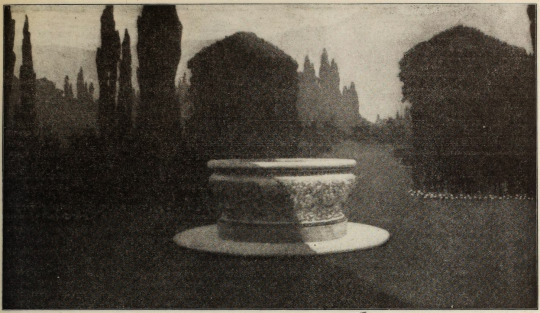

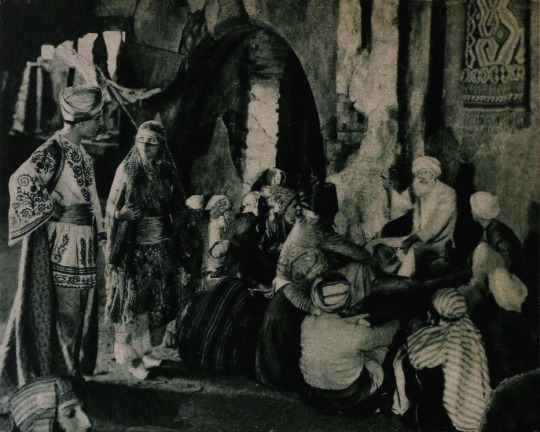

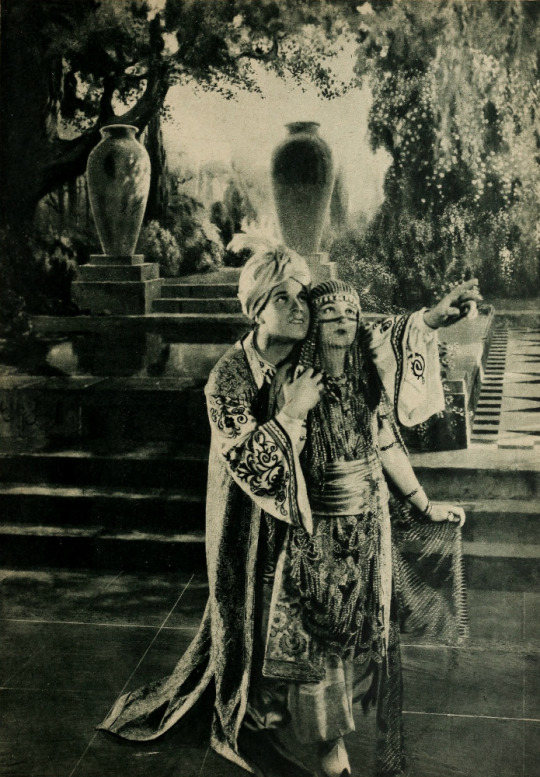
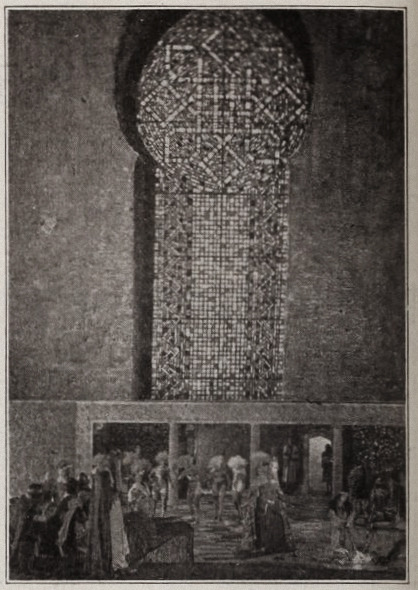
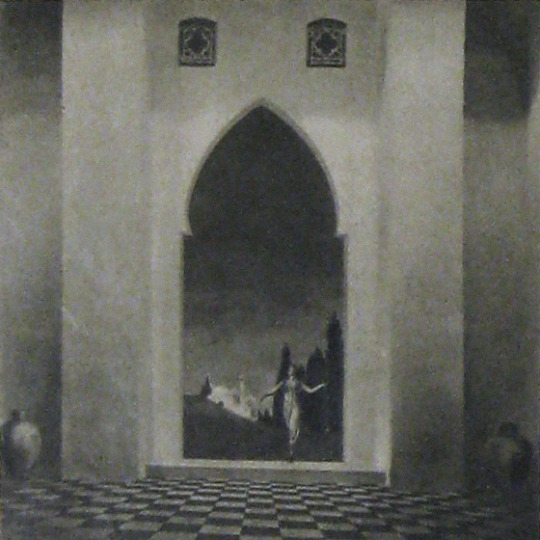
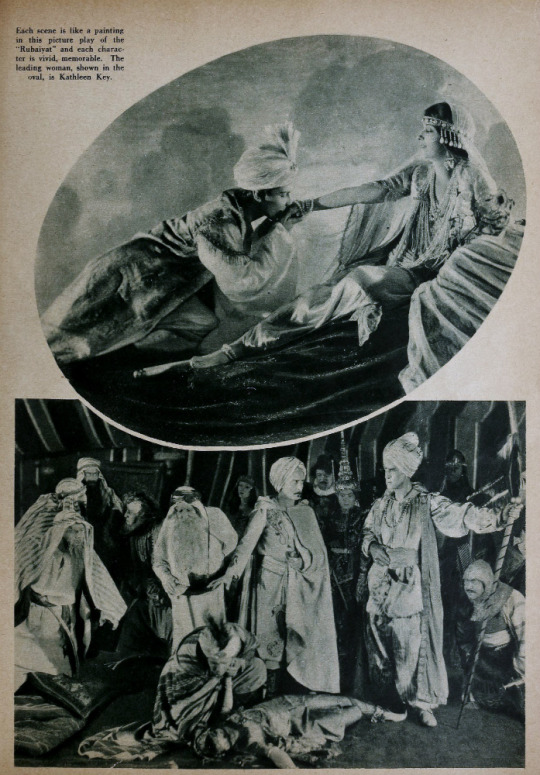



Alternate Titles: The Rubaiyat of Omar Khayyam, The Rubaiyat, Omar Khayyam, Omar
Direction: Ferdinand Pinney Earle; assisted by Walter Mayo
Scenario: Ferdinand P. Earle
Titles: Marion Ainslee, Ferdinand P. Earle (Omar), Louis Weadock (A Lover’s Oath)
Inspired by: The Rubaiyat of Omar Khayyam, as edited & translated by Edward FitzGerald
Production Manager: Winthrop Kelly
Camera: Georges Benoit
Still Photography: Edward S. Curtis
Special Photographic Effects: Ferdinand P. Earle, Gordon Bishop Pollock
Composer: Charles Wakefield Cadman
Editors: Arthur D. Ripley (The Rubaiyat of Omar Khayyam version), Ethel Davey & Ferdinand P. Earle (Omar / Omar Khayyam, the Director’s cut of 1922), Milton Sills (A Lover’s Oath)
Scenic Artists: Frank E. Berier, Xavier Muchado, Anthony Vecchio, Paul Detlefsen, Flora Smith, Jean Little Cyr, Robert Sterner, Ralph Willis
Character Designer: Louis Hels
Choreography: Ramon Novarro (credited as Ramon Samaniegos)
Technical Advisors: Prince Raphael Emmanuel, Reverend Allan Moore, Captain Dudley S. Corlette, & Captain Montlock or Mortlock
Studio: Ferdinand P. Earle Productions / The Rubaiyat, Inc. (Production) & Eastern Film Corporation (Distribution, Omar), Astor Distribution Corporation [States Rights market] (Distribution, A Lover’s Oath)
Performers: Frederick Warde, Edwin Stevens, Hedwiga Reicher, Mariska Aldrich, Paul Weigel, Robert Anderson, Arthur Carewe, Jesse Weldon, Snitz Edwards, Warren Rogers, Ramon Novarro (originally credited as Ramon Samaniegos), Big Jim Marcus, Kathleen Key, Charles A. Post, Phillippe de Lacy, Ferdinand Pinney Earle
Premiere(s): Omar cut: April 1922 The Ambassador Theatre, New York, NY (Preview Screening), 12 October 1923, Loew’s New York, New York, NY (Preview Screening), 2 February 1923, Hoyt’s Theatre, Sydney, Australia (Initial Release)
Status: Presumed lost, save for one 30 second fragment preserved by the Academy Film Archive, and a 2.5 minute fragment preserved by a private collector (Old Films & Stuff)
Length: Omar Khayyam: 8 reels , 76 minutes; A Lover’s Oath: 6 reels, 5,845 feet (though once listed with a runtime of 76 minutes, which doesn’t line up with the stated length of this cut)
Synopsis (synthesized from magazine summaries of the plot):
Omar Khayyam:
Set in 12th century Persia, the story begins with a preface in the youth of Omar Khayyam (Warde). Omar and his friends, Nizam (Weigel) and Hassan (Stevens), make a pact that whichever one of them becomes a success in life first will help out the others. In adulthood, Nizam has become a potentate and has given Omar a position so that he may continue his studies in mathematics and astronomy. Hassan, however, has grown into quite the villain. When he is expelled from the kingdom, he plots to kidnap Shireen (Key), the sheik’s daughter. Shireen is in love with Ali (Novarro). In the end it’s Hassan’s wife (Reicher) who slays the villain then kills herself.
A Lover’s Oath:
The daughter of a sheik, Shireen (Key), is in love with Ali (Novarro), the son of the ruler of a neighboring kingdom. Hassan covets Shireen and plots to kidnap her. Hassan is foiled by his wife. [The Sills’ edit places Ali and Shireen as protagonists, but there was little to no re-shooting done (absolutely none with Key or Novarro). So, most critics note how odd it is that all Ali does in the film is pitch woo, and does not save Shireen himself. This obviously wouldn’t have been an issue in the earlier cut, where Ali is a supporting character, often not even named in summaries and news items. Additional note: Post’s credit changes from “Vizier” to “Commander of the Faithful”]
Additional sequence(s) featured in the film (but I’m not sure where they fit in the continuity):
Celestial sequences featuring stars and planets moving through the cosmos
Angels spinning in a cyclone up to the heavens
A Potters’ shop sequence (relevant to a specific section of the poems)
Harem dance sequence choreographed by Novarro
Locations: palace gardens, street and marketplace scenes, ancient ruins
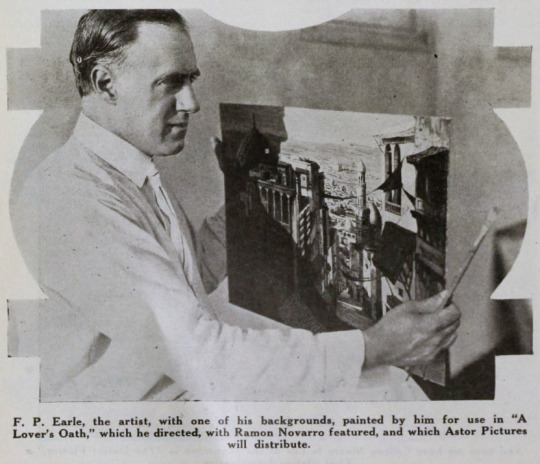

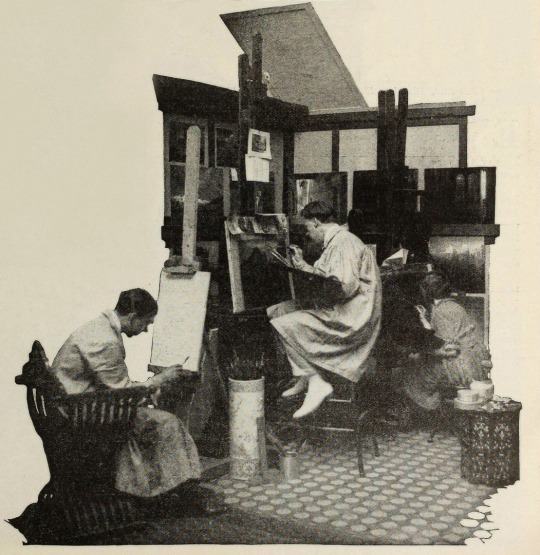
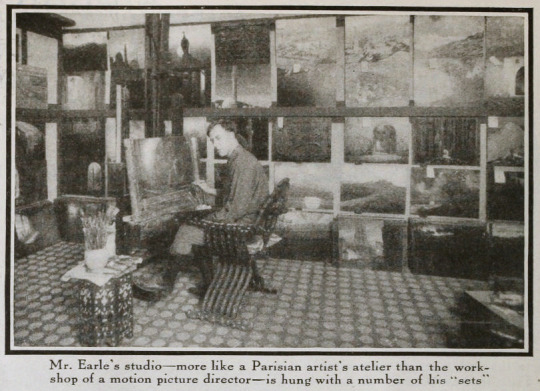
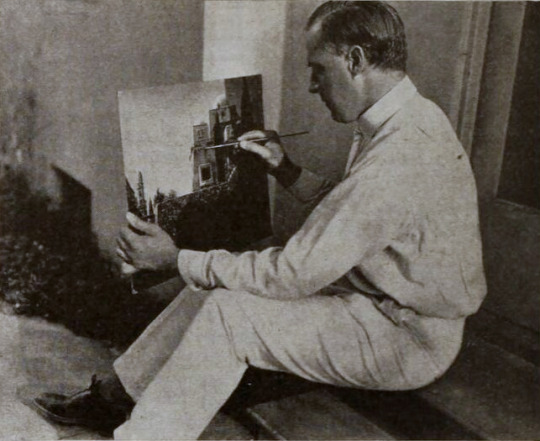
Points of Interest:
“The screen has been described as the last word in realism, but why confine it there? It can also be the last word in imaginative expression.”
Ferdinand P. Earle as quoted in Exhibitors Trade Review, 4 March 1922
The Rubaiyat of Omar Khayyam was a massive best seller. Ferdinand Pinney Earle was a classically trained artist who studied under William-Adolphe Bougueraeu and James McNeill Whistler in his youth. He also had years of experience creating art backgrounds, matte paintings, and art titles for films. Charles Wakefield Cadman was an accomplished composer of songs, operas, and operettas. Georges Benoit and Gordon Pollock were experienced photographic technicians. Edward S. Curtis was a widely renowned still photographer. Ramon Novarro was a name nobody knew yet—but they would soon enough.
When Earle chose The Rubaiyat as the source material for his directorial debut and collected such skilled collaborators, it seemed likely that the resulting film would be a landmark in the art of American cinema. Quite a few people who saw Earle’s Rubaiyat truly thought it would be:
William E. Wing writing for Camera, 9 September 1922, wrote:
“Mr. Earle…came from the world of brush and canvass, to spread his art upon the greater screen. He created a new Rubaiyat with such spiritual colors, that they swayed.” … “It has been my fortune to see some of the most wonderful sets that this Old Earth possesses, but I may truly say that none seized me more suddenly, or broke with greater, sudden inspiration upon the view and the brain, than some of Ferdinand Earle’s backgrounds, in his Rubaiyat. “His vision and inspired art seem to promise something bigger and better for the future screen.”
As quoted in an ad in Film Year Book, 1923:
“Ferdinand Earle has set a new standard of production to live up to.”
Rex Ingram
“Fifty years ahead of the time.”
Marshall Neilan
The film was also listed among Fritz Lang’s Siegfried, Chaplin’s Gold Rush, Fairbanks’ Don Q, Lon Chaney’s Phantom of the Opera and The Unholy Three, and Erich Von Stroheim’s Merry Widow by the National Board of Review as an exceptional film of 1925.
So why don’t we all know about this film? (Spoiler: it’s not just because it’s lost!)
The short answer is that multiple dubious legal challenges arose that prevented Omar’s general release in the US. The long answer follows BELOW THE JUMP!
Earle began the project in earnest in 1919. Committing The Rubaiyat to film was an ambitious undertaking for a first-time director and Earle was striking out at a time when the American film industry was developing an inferiority complex about the level of artistry in their creative output. Earle was one of a number of artists in the film colony who were going independent of the emergent studio system for greater protections of their creative freedoms.
In their adaptation of The Rubaiyat of Omar Khayyam, Earle and Co. hoped to develop new and perfect existing techniques for incorporating live-action performers with paintings and expand the idea of what could be accomplished with photographic effects in filmmaking. The Rubaiyat was an inspired choice. It’s not a narrative, but a collection of poetry. This gave Earle the opportunity to intersperse fantastical, poetic sequences throughout a story set in the lifetime of Omar Khayyam, the credited writer of the poems. In addition to the fantastic, Earle’s team would recreate 12th century Persia for the screen.
Earle was convinced that if his methods were perfected, it wouldn’t matter when or where a scene was set, it would not just be possible but practical to put on film. For The Rubaiyat, the majority of shooting was done against black velvet and various matte photography and multiple exposure techniques were employed to bring a setting 800+ years in the past and 1000s of miles removed to life before a camera in a cottage in Los Angeles.
Note: If you’d like to learn a bit more about how these effects were executed at the time, see the first installment of How’d They Do That.
Unfortunately, the few surviving minutes don’t feature much of this special photography, but what does survive looks exquisite:
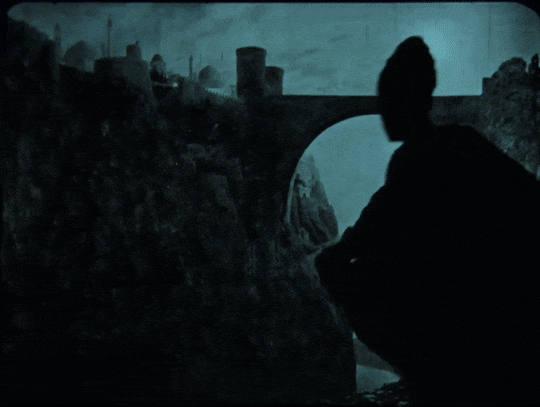
see all gifs here
Earle, knowing that traditional stills could not be taken while filming, brought in Edward S. Curtis. Curtis developed techniques in still photography to replicate the look of the photographic effects used for the film. So, even though the film hasn’t survived, we have some pretty great looking representations of some of the 1000s of missing feet of the film.
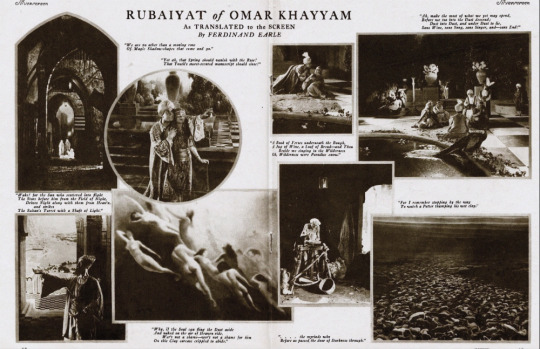
Nearly a year before Curtis joined the crew, Earle began collaboration with composer Charles Wakefield Cadman. In another bold creative move, Cadman and Earle worked closely before principal photography began so that the score could inform the construction and rhythm of the film and vice versa.
By the end of 1921 the film was complete. After roughly 9 months and the creation of over 500 paintings, The Rubaiyat was almost ready to meet its public. However, the investors in The Rubaiyat, Inc., the corporation formed by Earle to produce the film, objected to the ample reference to wine drinking (a comical objection if you’ve read the poems) and wanted the roles of the young lovers (played by as yet unknown Ramon Novarro and Kathleen Key) to be expanded. The dispute with Earle became so heated that the financiers absconded with the bulk of the film to New York. Earle filed suit against them in December to prevent them from screening their butchered and incomplete cut. Cadman supported Earle by withholding the use of his score for the film.
Later, Eastern Film Corp. brokered a settlement between the two parties, where Earle would get final cut of the film and Eastern would handle its release. Earle and Eastern agreed to change the title from The Rubaiyat of Omar Khayyam to simply Omar. Omar had its first official preview in New York City. It was tentatively announced that the film would have a wide release in the autumn.
However, before that autumn, director Norman Dawn launched a dubious patent-infringement suit against Earle and others. Dawn claimed that he owned the sole right to use multiple exposures, glass painting for single exposure, and other techniques that involved combining live action with paintings. All the cited techniques had been widespread in the film industry for a decade already and eventually and expectedly Dawn lost the suit. Despite Earle’s victory, the suit effectively put the kibosh on Omar’s release in the US.
Earle moved on to other projects that didn’t come to fruition, like a Theda Bara film and a frankly amazing sounding collaboration with Cadman to craft a silent-film opera of Faust. Omar did finally get a release, albeit only in Australia. Australian news outlets praised the film as highly as those few lucky attendees of the American preview screenings did. The narrative was described as not especially original, but that it was good enough in view of the film’s artistry and its imaginative “visual phenomena” and the precision of its technical achievement.
One reviewer for The Register, Adelaide, SA, wrote:
“It seems almost an impossibility to make a connected story out of the short verse of the Persian of old, yet the producer of this classic of the screen… has succeeded in providing an entertainment that would scarcely have been considered possible. From first to last the story grips with its very dramatic intensity.”
While Omar’s American release was still in limbo, “Ramon Samaniegos” made a huge impression in Rex Ingram’s Prisoner of Zenda (1922, extant) and Scaramouche (1923, extant) and took on a new name: Ramon Novarro. Excitement was mounting for Novarro’s next big role as the lead in the epic Ben-Hur (1925, extant) and the Omar project was re-vivified.
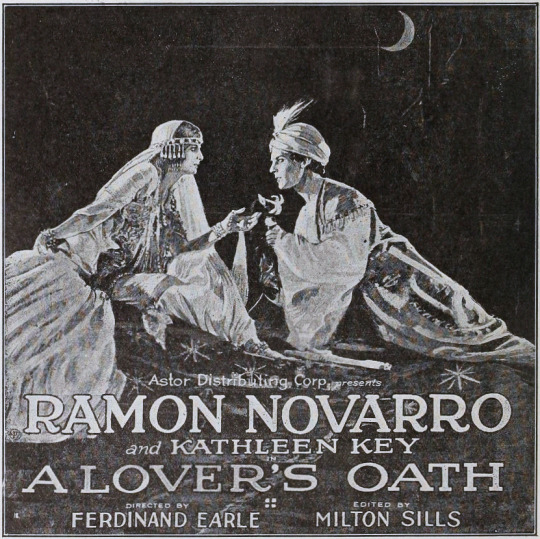
A new company, Astor Distribution Corp., was formed and purchased the distribution rights to Omar. Astor hired actor (note, not an editor) Milton Sills to re-cut the film to make Novarro and Key more prominent. The company also re-wrote the intertitles, reduced the films runtime by more than ten minutes, and renamed the film A Lover’s Oath. Earle had moved on by this point, vowing to never direct again. In fact, Earle was indirectly working with Novarro and Key again at the time, as an art director on Ben-Hur!
Despite Omar’s seemingly auspicious start in 1920, it was only released in the US on the states rights market as a cash-in on the success of one of its actors in a re-cut form five years later.
That said, A Lover’s Oath still received some good reviews from those who did manage to see it. Most of the negative criticism went to the story, intertitles, and Sills’ editing.
What kind of legacy could/should Omar have had? I’m obviously limited in my speculation by the fact that the film is lost, but there are a few key facts about the film’s production, release, and timing to consider.
The production budget was stated to be $174,735. That is equivalent to $3,246,994.83 in 2024 dollars. That is a lot of money, but since the production was years long and Omar was a period film set in a remote locale and features fantastical special effects sequences, it’s a modest budget. For contemporary perspective, Robin Hood (1922, extant) cost just under a million dollars to produce and Thief of Bagdad (1924, extant) cost over a million. For a film similarly steeped in spectacle to have nearly 1/10th of the budget is really very noteworthy. And, perhaps if the film had ever had a proper release in the US—in Earle’s intended form (that is to say, not the Sills cut)—Omar may have made as big of a splash as other epics.
It’s worth noting here however that there are a number of instances in contemporary trade and fan magazines where journalists off-handedly make this filmmaking experiment about undermining union workers. Essentially implying that that value of Earle’s method would be to continue production when unionized workers were striking. I’m sure that that would absolutely be a primary thought for studio heads, but it certainly wasn’t Earle’s motivation. Often when Earle talks about the method, he focuses on being able to film things that were previously impossible or impracticable to film. Driving down filming costs from Earle’s perspective was more about highlighting the artistry of his own specialty in lieu of other, more demanding and time-consuming approaches, like location shooting.
This divide between artists and studio decision makers is still at issue in the American film and television industry. Studio heads with billion dollar salaries constantly try to subvert unions of skilled professionals by pursuing (as yet) non-unionized labor. The technical developments of the past century have made Earle’s approach easier to implement. However, just because you don’t have to do quite as much math, or time an actor’s movements to a metronome, does not mean that filming a combination of painted/animated and live-action elements does not involve skilled labor.
VFX artists and animators are underappreciated and underpaid. In every new movie or TV show you watch there’s scads of VFX work done even in films/shows that have mundane, realistic settings. So, if you love a film or TV show, take the effort to appreciate the work of the humans who made it, even if their work was so good you didn’t notice it was done. And, if you’ve somehow read this far, and are so out of the loop about modern filmmaking, Disney’s “live-action” remakes are animated films, but they’ve just finagled ways to circumvent unions and low-key delegitimize the skilled labor of VFX artists and animators in the eyes of the viewing public. Don’t fall for it.
VFX workers in North America have a union under IATSE, but it’s still developing as a union and Marvel & Disney workers only voted to unionize in the autumn of 2023. The Animation Guild (TAG), also under the IATSE umbrella, has a longer history, but it’s been growing rapidly in the past year. A strike might be upcoming this year for TAG, so keep an eye out and remember to support striking workers and don’t cross picket lines, be they physical or digital!
Speaking of artistry over cost-cutting, I began this post with a mention that in the early 1920s, the American film industry was developing an inferiority complex in regard to its own artistry. This was in comparison to the European industries, Germany’s being the largest at the time. It’s frustrating to look back at this period and see acceptance of the opinion that American filmmakers weren’t bringing art to film. While yes, the emergent studio system was highly capitalistic and commercial, that does not mean the American industry was devoid of home-grown artists.
United Artists was formed in 1919 by Douglas Fairbanks, Charlie Chaplin, Mary Pickford, and D.W. Griffith precisely because studios were holding them back from investing in their art—within the same year that Earle began his Omar project. While salaries and unforgiving production schedules were also paramount concerns in the filmmakers going independent, a primary impetus was that production/distribution heads exhibited too much control over what the artists were trying to create.
Fairbanks was quickly expanding his repertoire in a more classical and fantastic direction. Cecil B. DeMille made his first in a long and very successful string of ancient epics. And the foreign-born children of the American film industry, Charlie Chaplin, Rex Ingram, and Nazimova, were poppin’ off! Chaplin was redefining comedic filmmaking. Ingram was redefining epics. Nazimova independently produced what is often regarded as America’s first art film, Salome (1923, extant), a film designed by Natacha Rambova, who was *gasp* American. Earle and his brother, William, had ambitious artistic visions of what could be done in the American industry and they also had to self-produce to get their work done.
Meanwhile, studio heads, instead of investing in the artists they already had contracts with, tried to poach talent from Europe with mixed success (in this period, see: Ernst Lubitsch, F.W. Murnau, Benjamin Christensen, Mauritz Stiller, Victor Sjöström, and so on). I’m in no way saying it was the wrong call to sign these artists, but all of these filmmakers, even if they found success in America, had stories of being hired to inject the style and artistry that they developed in Europe into American cinema, and then had their plans shot down or cut down to a shadow of their creative vision. Even Stiller, who tragically died before he had the opportunity to establish himself in the US, faced this on his first American film, The Temptress (1926, extant), on which he was replaced. Essentially, the studio heads’ actions were all hot air and spite for the filmmakers who’d gone independent.
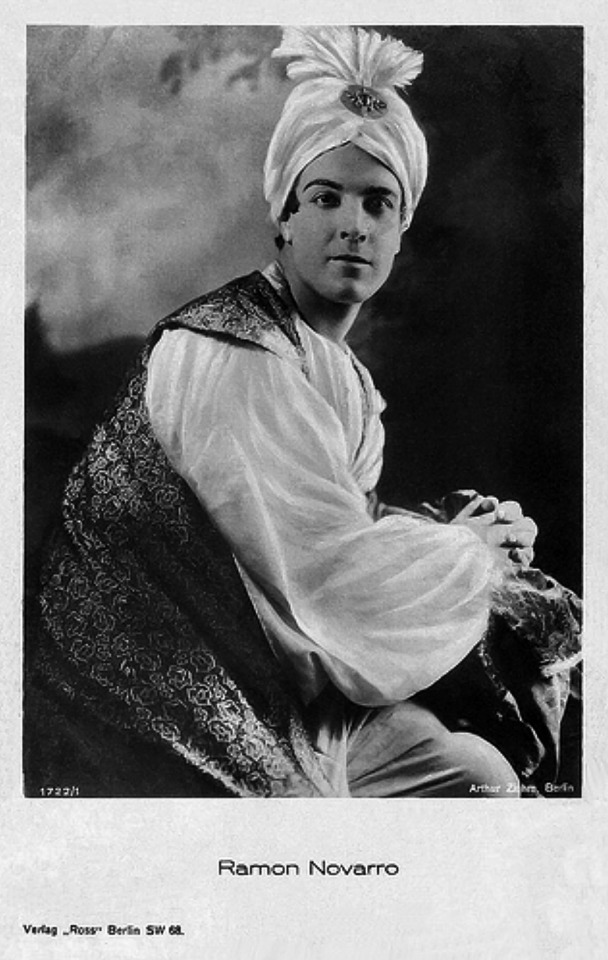
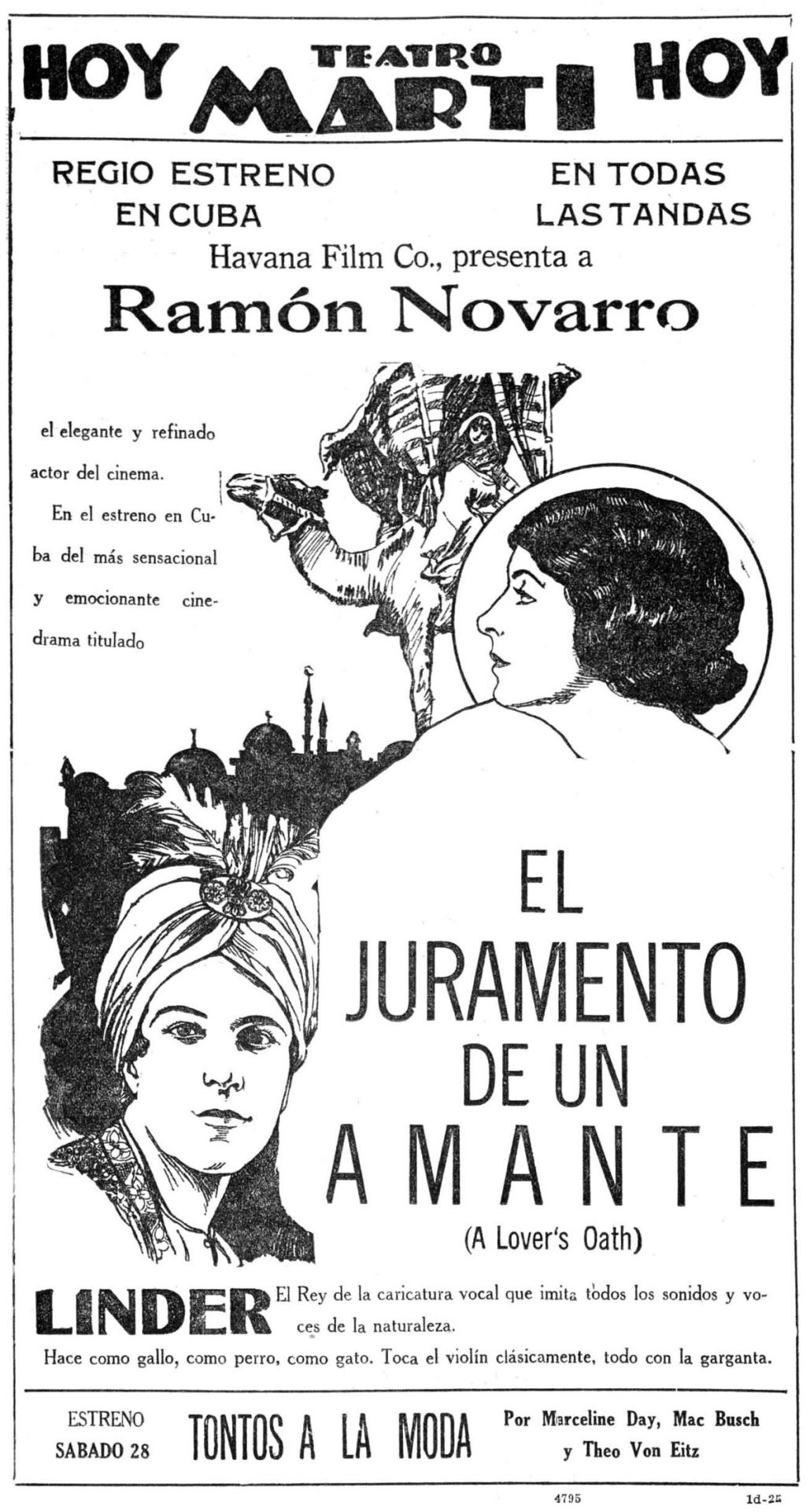
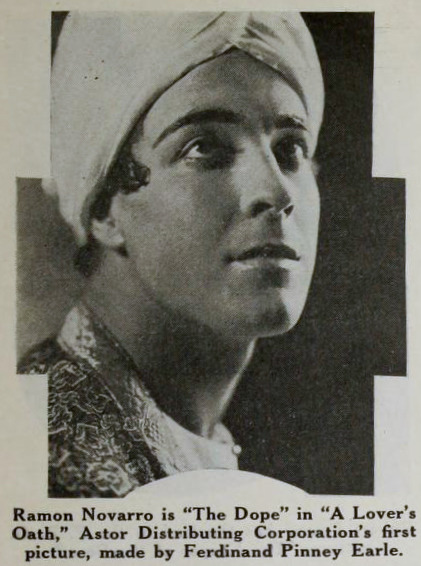
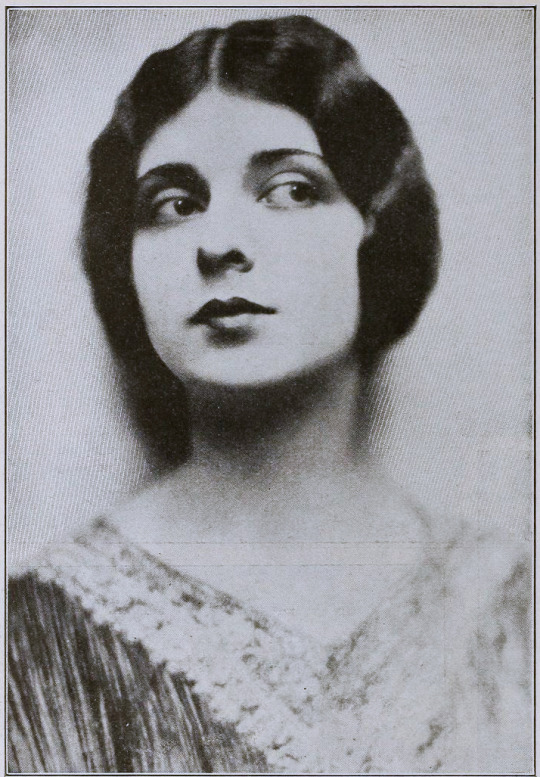

Finally I would like to highlight Ferdinand Earle’s statement to the industry, which he penned for from Camera in 14 January 1922, when his financial backers kidnapped his film to re-edit it on their terms:
MAGNA CHARTA
Until screen authors and producers obtain a charter specifying and guaranteeing their privileges and rights, the great slaughter of unprotected motion picture dramas will go merrily on.
Some of us who are half artists and half fighters and who are ready to expend ninety per cent of our energy in order to win the freedom to devote the remaining ten per cent to creative work on the screen, manage to bring to birth a piteous, half-starved art progeny.
The creative artist today labors without the stimulus of a public eager for his product, labors without the artistic momentum that fires the artist’s imagination and spurs his efforts as in any great art era.
Nowadays the taint of commercialism infects the seven arts, and the art pioneer meets with constant petty worries and handicaps.
Only once in a blue moon, in this matter-of-fact, dollar-wise age can the believer in better pictures hope to participate in a truely [sic] artistic treat.
In the seven years I have devoted to the screen, I have witnessed many splendid photodramas ruined by intruding upstarts and stubborn imbeciles. And I determined not to launch the production of my Opus No. 1 until I had adequately protected myself against all the usual evils of the way, especially as I was to make an entirely new type of picture.
In order that my film verison [sic] of the Rubaiyat of Omar Khayyam might be produced under ideal conditions and safeguarded from intolerable interferences and outside worries, I entered into a contract with the Rubaiyat, Inc., that made me not only president of the corporation and on the board of directors, but which set forth that I was to be author, production manager, director, cutter and film editor as well as art director, and that no charge could be made against the production without my written consent, and that my word was to be final on all matters of production. The late George Loane Tucker helped my attorney word the contract, which read like a splendid document.
Alas, I am now told that only by keeping title to a production until it is declared by yourself to be completed is it safe for a scenario writer, an actor or a director, who is supposedly making his own productions, to contract with a corporation; otherwise he is merely the servant of that corporation, subject at any moment to discharge, with the dubious redress of a suit for damages that can with difficulty be estimated and proven.
Can there be any hope of better pictures as long as contracts and copyrights are no protection against financial brigands and bullies?
We have scarcely emerged from barbarism, for contracts, solemnly drawn up between human beings, in which the purposes are set forth in the King’s plainest English, serve only as hurdles over which justice-mocking financiers and their nimble attorneys travel with impunity, riding rough shod over the author or artist who cannot support a legal army to defend his rights. The phrase is passed about that no contract is invioliable [sic]—and yet we think we have reached a state of civilization!
The suit begun by my attorneys in the federal courts to prevent the present hashed and incomplete version of my story from being released and exhibited, may be of interest to screen writers. For the whole struggle revolves not in the slightest degree around the sanctity of the contract, but centers around the federal copyright of my story which I never transferred in writing otherwise, and which is being brazenly ignored.
Imagine my production without pictorial titles: and imagine “The Rubaiyat” with a spoken title as follows, “That bird is getting to talk too much!”—beside some of the immortal quatrains of Fitzgerald!
One weapon, fortunately, remains for the militant art creator, when all is gone save his dignity and his sense of humor; and that is the rapier blade of ridicule, that can send lumbering to his retreat the most brutal and elephant-hided lord of finance.
How edifying—the tableau of the man of millions playing legal pranks upon men such as Charles Wakefield Cadman, Edward S. Curtis and myself and others who were associated in the bloody venture of picturizing the Rubaiyat! It has been gratifying to find the press of the whole country ready to champion the artist’s cause.
When the artist forges his plowshare into a sword, so to speak, he does not always put up a mean fight.
What publisher would dare to rewrite a sonnet of John Keats or alter one chord of a Chopin ballade?
Creative art of a high order will become possible on the screen only when the rights of established, independent screen producers, such as Rex Ingram and Maurice Tourneur, are no longer interferred with and their work no longer mutilated or changed or added to by vandal hands. And art dramas, conceived and executed by masters of screen craft, cannot be turned out like sausages made by factory hands. A flavor of individuality and distinction of style cannot be preserved in machine-made melodramas—a drama that is passed from hand to hand and concocted by patchworkers and tinkerers.
A thousand times no! For it will always be cousin to the sausage, and be like all other—sausages.
The scenes of a master’s drama may have a subtle pictorial continuity and a power of suggestion quite like a melody that is lost when just one note is changed. And the public is the only test of what is eternally true or false. What right have two or three people to deprive millions of art lovers of enjoying an artist’s creation as it emerged from his workshop?
“The Rubaiyat” was my first picture and produced in spite of continual and infernal interferences. It has taught me several sad lessons, which I have endeavored in the above paragraphs to pass on to some of my fellow sufferers. It is the hope that I am fighting, to a certain extent, their battle that has given me the courage to continue, and that has prompted me to write this article. May such hubbubs eventually teach or inforce a decent regard for the rights of authors and directors and tend to make the existence of screen artisans more secure and soothing to the nerves.
FERDINAND EARLE.
---
☕Appreciate my work? Buy me a coffee! ☕
Transcribed Sources & Annotations over on the WMM Blog!
See the Timeline for Ferdinand P. Earle's Rubaiyat Adaptation
#1920s#1923#1925#omar khayyam#ferdinand pinney earle#ramon novarro#independent film#american film#silent cinema#silent era#silent film#classic cinema#classic movies#classic film#film history#history#Charles Wakefield Cadman#cinematography#The Rubaiyat#cinema#film#lost film
50 notes
·
View notes
Text

2024 : Quite Study One [BANG'N'ZOZ]
Mortlock Chamber, State Library of South Australia, Adelaide.
9 notes
·
View notes
Text
Demonology for Beginners: Part 1
I have several hundred books in my library, so this is a very brief selection, aimed at beginners.
Most of these can be found on kindle. (With one or two exceptions)
.
On Demons
Ars Goetia
The Devil’s Grimoire: A System of Psychic Attack by Moribus Mortlock (On how to use Devils for magical purposes)
Demons, the Devil, and Fallen Angels by Marie D. Jones & Larry Flaxman
Liber Asmodeus by Diablito Ordo Al-Ghoul (A Newer edition named Asmodeus exists, but not on Kindle. I recommend getting both, as the information covers different grounds, for all that the newer edition is more comprehensive.)
Demonality: Incubi & Succubi by Sinistrari of Ameno (17th Century) (New Ed. by Tarl Warwick)
A Brief History of Angels and Demons by Sarah Bartlett
Demonology: Sorting Facts from Fiction: A field guide of Demons in cristianity by Riley Star (The most basic beginner book of Demons and Demonology possible. HIGHLY recommended reading for a beginner. Oversimplified, but a great place to start. Comes with a list of some of the better known demons.)
.
On the Darkness, Hell, and the Left-Handed Path
Lords of the Left-Handed Path: Forbidden Practices and Spiritual Heresies by Stephen E. Flowers (Recommended by the Temple of Set)
Pacts With the Devil by Black (In all fairness a history lesson with a number of magical principles that are useful to know on top.)
The Penguin Book of Hell (Penguin Classics)
.
Novels that Portray Demons More or Less Accurately
(Take it with a pinch of salt. It’s still fiction. But rather good fiction.)
Mr. B. Gone by Clive Barker
The Devil’s Mistress by J.W. Brodie-Innes (Based on a true story dating back to the witch trials. True to real events as far as can be documented.)
The Magus by Alex Sumner (VERY Accurate...for the specific demons and magic involved. Be aware many other demons are far less dangerous.)
.
YouTube Videos:
Example of Working With a Demon:
https://www.youtube.com/watch?v=csom7YmpdzY
Working With Demons, Playlist:
https://www.youtube.com/watch?v=VKvSCFogl6M&list=PLITSa3x4sSXnjgEBXinH1560Sdeupcb-X
.
Tarot/Oracle Decks
Decent deck:
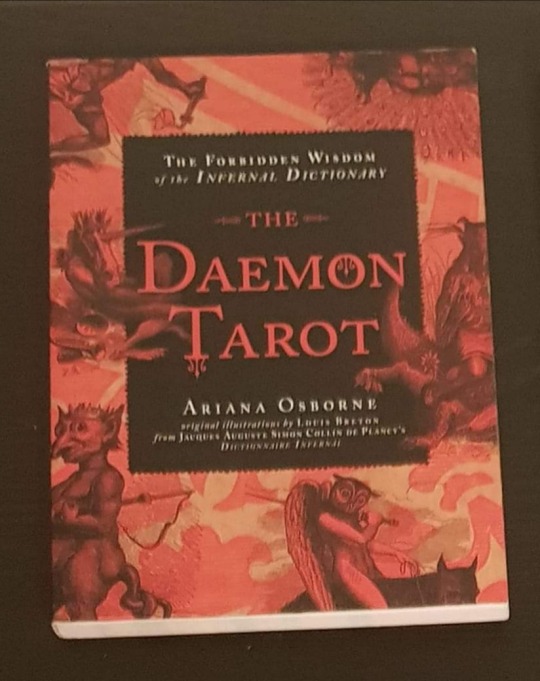
.
Best Deck:
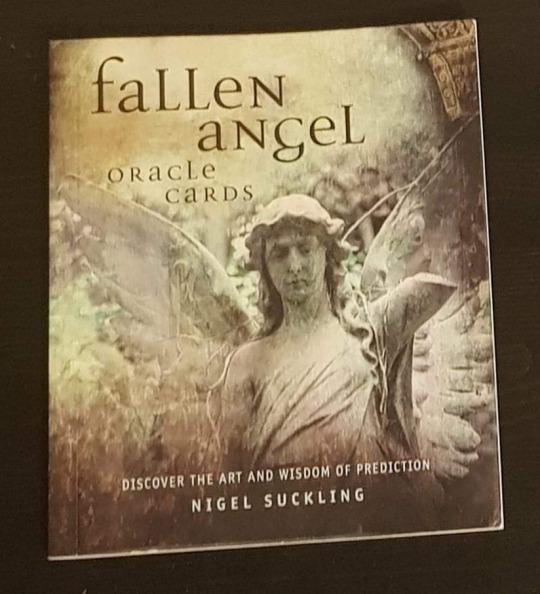
.
Notes
Some people would recommend the works of S. Connolly, but I personally find that person a bit too quixotic when it comes to demons. They are good for ideas, but following everything in them could prove...risky.
Demons are not friendly spirits or deities. They are not nice or benevolent just to be kind. They want something, even if that something is to seduce you to join the dark delights of Hell. Or offerings you may give them.
.
I realize this can seem a bit scary at first glance. And perhaps I do go a bit deep into the Darker aspects of Demon and Demonology.
But keep in mind that Demons are not your enemies. They are your Allies and Friends.
At least that is what you hope to achieve.
Hell can seem like a bad place to those who are not at home with Darkness, Wickedness, Cruelty, and Suffering.
But those who have known these things, who accept them, will find it a very nice and inviting home.
Working with Demons are not for the squeamish. It’s not some fashion fad to follow and then discard. And it’s not for those who cannot take it seriously and do the work you need to do.
But do it right, and you can have all the Wealth, Wisdom, Secrets, and Power in the world laid at your feet.
And in the end, you will find out if you are one of the few whom will find a Home in Hell... or if it’s simply not for you.
--Belial
32 notes
·
View notes
Text
REENIE GETS COLTER TO TAKE A CASE INVOLVING A WOMAN MISSING FROM A HIGH-END WELLNESS RETREAT, ON “TRACKER,” SUNDAY, NOV. 3

Michael Rady Guest Stars as Elliot, Reenie’s Plus One for the Retreat
“Noble Rot” – Reenie gets Colter to take a case involving a woman missing from a high-end wellness retreat in Napa designed for CEOs, on the CBS Original series TRACKER, Sunday, Nov. 3 (8:00-9:00 PM, ET/PT) on the CBS Television Network, and streaming on Paramount+*(live and on-demand for Paramount+ with SHOWTIME subscribers, or on-demand for Paramount+ Essential subscribers the day after the episode airs)*. Michael Rady guest stars as Elliot, Reenie’s plus one for the retreat.
WRITTEN BY: Alex Katsnelson & Amanda Mortlock
DIRECTED BY: Aprill Winney
1 note
·
View note
Text

DESCENT INTO AVERNUS. references for my own benefit! please blacklist #descent into avernus ref if not interested in seeing this content! i cannot provide alt text to the images from the handbook, however, i will be showing notes on what i read in between screenshots!
PART ONE: chapter one of the descent into avernus guide book. shitty screenshots and summaries

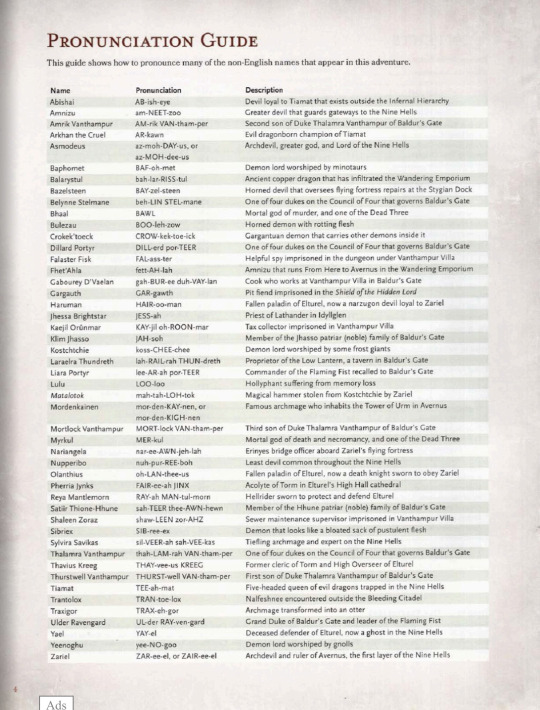
Important to WYLL:
baphomet is a demon lord worshipped by minotaurs. wyll has fought a minotaur in his many journeys, it is one of his favorite and most impressive stories to tell
belynne stelmane : of emperor alliance fame, she had a stroke due to the emperor, wyll had a crush on her, she is one of the four dukes
dillard potyr: another of the four dukes
klim jhasso: member of the noble family, the jhassos
mortlock and thurswell vanthampur: 3rd son and 1st of duke thalmara vanthampur
thalmara vamthampur: duke of bg
tiamut: five headed dragon queen of evil dragons, wyll stopped this dragon from taking over the city 7 years ago with mizora
grandduke ulder ravengard: wyll’s dad, obvs lol
thavius kreeg: high overseer of elturel, this is the place and person ulder went to go see before it fell
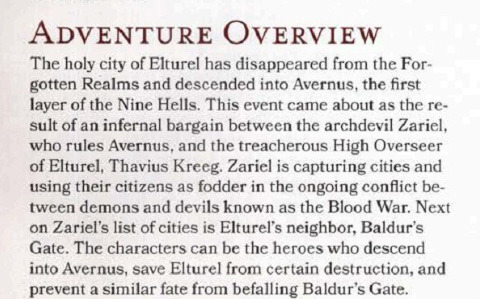
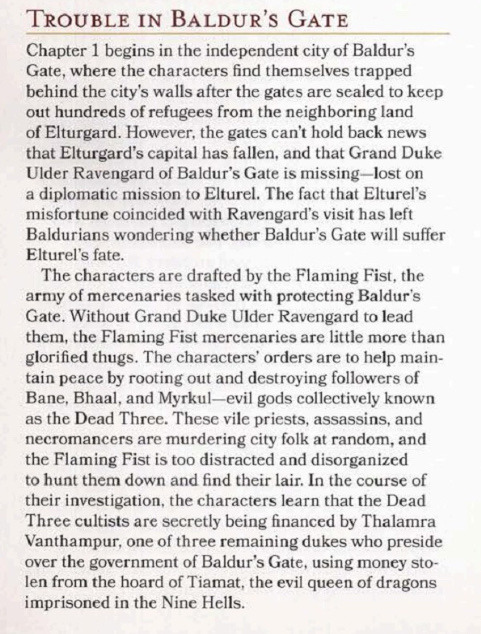
notes: zariel intends to take ofer baldurs gate next, zariel and thavius kreeg, the high overseer, have an infernal contract.
ulder is missing after having gone to elturel. the flaming fist is useless without him, and are even referred to as “distracted” and “thugs.” there are HUNDREDS of refugees trying to get in, the dead three already has its claws in bg obviously.
thalmura vhampur using tiamut’s gold (tiamut if u remember was the reason wyll was banished) to fund the dead threes murders
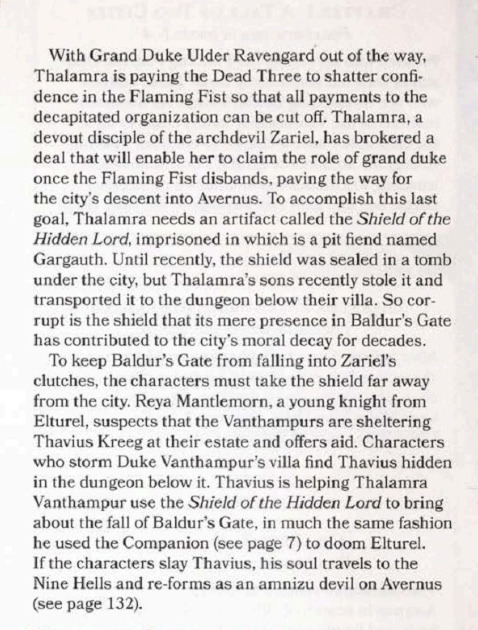
thalmura is doing this to “shatter the confidence” of people who believe in the flaming fist, and get them defunded. she has made a deal with zariel that when the fist is disbanded, she will take over as grandduke.
the shield of the hidden lord will help her smack bg into hell, and has been corrupting the morals of bg for “decades.” i guess this means if u take it away it’ll make bg better! her sons have stolen it

ulder is “valiant” but he “opposes” elturel
zariel was once an angel and you can redeem her, wild

zariel wanted the other angels to fight in thr blood war between demons and devils, she made an army called the hellriders, the hellriders LEFT her gay ass there, and kept that a secret from the world
zariel lost her army but also her hand and her sword she was holding. she told yael, her bff general, to take the sword and get out. ollianthius and haruman, her other two besties, refused to leave her side. they were sent to nessus, the lowest of the hells
asmodeus was like i know u tried to kill is but that was so cool, rule avernus for me bestie? and bel was mad about it, but zariel wanted to fight demons so fuckin bad she said yes. haruman was like ok bestie lets go. olanthius killed himself bc he was NOT a true ride or die, but zariel brought him back as a zombie, bc fuck u olanthius, that’s why
zariel ALWAYS wanted revenge on the hellriders, who went to eltruel. in 1444 dr, she got her chance. they were raken over by a vampire lord. thavius, a priest of thorm, appealed to any power to save his city, zariel said “hi” and he accepted her deal, and elturel was safe.
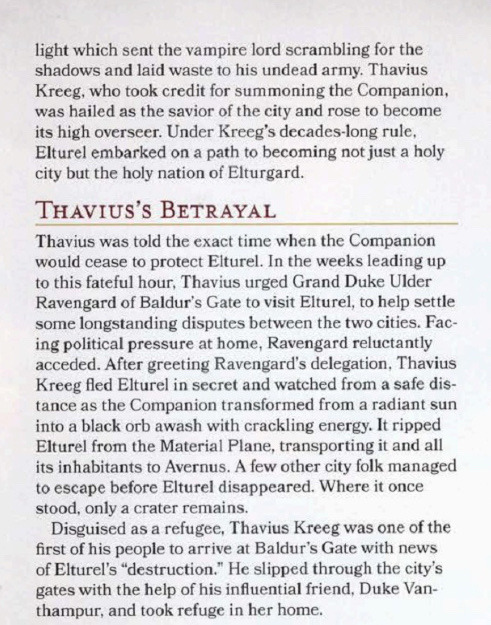
EXCEPT THAT IT WASN’T!!!
thavius actually just became high overseer, only to ask ravengard to come on over RIGHT BEFORE the time limit was up and elturel would be pulled to hell!! ravengard didn’t even WANT to go, he was pressured to, probs bc elturel was gaining power n turning into a proper nation, and they have various disputes that make ulder “at odds” with them!
thavius greeted the duke and then LEFT HIM THERE to “watch from a safe distance” then disguised himself as a refugee and then tells everyone elturel has fallen with HUNDREDS OF HIS OWN PEOPLE THA5 ARE REFUGEES BC OF HIS EVIL ASS, and then goes to chill with duke vanthampur in her VILLA, while all the tieflings are in RAGS.
more to come……..
7 notes
·
View notes
Text
NHL Breakaway 98

NA release: 25th February 1998
PAL release: 25th February 1998
JP release: N/A
Developer: Iguana
Publisher: Acclaim
N64 Magazine Score: 62%

Graphically, NHL Breakaway looks much more “real” compared too Wayne Gretzky, with human-shaped proportions and an ice rink that has reflections (although not of players). It also seems to be more in-tune with a proper Ice Hockey viewing experience (I presume) with organ music playing American sports tunes.

Unfortunately, that’s where the good points for Breakaway end, as it’s nowhere near as fluid or fun to play as Wayne Gretzky. It’s all stiff, with some unresponsive controls and bad camera angles – I couldn’t find a single one I liked.

Similar to Igunana’s American Football game, NHL Breakaway also has some cheats, although none are as amusing as their previous one and they don’t really make the game any more fun.
This is just a bland sports game.
Everything’s neatly in place and functioning in its proper manner, but there’s no excitement, no originality. Basically, there’s nothing to make you want to rush out and buy the game.
- Dean Mortlock, N64 Magazine #14
Remake or Remaster?
Sports games constantly get refreshed.
Official Ways to get the game
There’s no official way to play NHL Breakaway 98
3 notes
·
View notes
Text









raven mortlock
@noelle-coded meet raven
16 notes
·
View notes
Text
𝗣𝗘𝗢𝗣𝗟𝗘 𝗜'𝗗 𝗟𝗜𝗞𝗘 𝗧𝗢 𝗚𝗘𝗧 𝗧𝗢 𝗞𝗡𝗢𝗪 𝗕𝗘𝗧𝗧𝗘𝗥!
ALIAS / NAME : Luka
BIRTHDAY : Mid May
ZODIAC SIGN : Taurus - and my celtic zodiac tree is Hawthorn!
HEIGHT : About 5'7"
HOBBIES : Knitting, crochet, reading, writing
FAVORITE COLOR : Pale pinks and green
FAVORITE BOOK : It's a tie between Mortlock by Jon Mayhew and Enduring Love by Ian McEwan
LAST SONG : Queen of Peace - Florence and the Machine
LAST FILM / SHOW : Bob's Burgers (literally on as I type this XD)
RECENT READS : Pretty much every thread that appears on my dash (but also Mia West's Son's of Britain series)
INSPIRATION : Music, plotting with rp partners, and generally smushing other ideas together for extra content
STORY BEHIND URL: I have a lot of muses and I'm happy about it XD writing with people and making friends makes me happier than a lot of things, so, yeah.
FUN FACT ABOUT ME : I'm a witch! I read tarot and draw sigils and keep plants that represent my friends so I can look after them by looking after the plants (I only have 2 rn because the plants have to have the right energy, but I'm working on getting more!)
Tagged by: @shouga-nai (thank yoouuuu I love getting tagged in dash games ^-^) Tagging: I think everyone I would have tagged has already been tagged by somebody else soooo Steal it if you want it!
4 notes
·
View notes
Text

The interior of the historic Mortlock Library, in the State Library of South Australia, Adelaide
9 notes
·
View notes
Text
Diary Entry 2

It’s been a strange, unsettling day. It started simply enough. I met Elwaren, a copper-skinned elf with an aura of quiet confidence. We’ve been working as deputies, tracking down the cultists who’ve been responsible for the recent killings—followers of the Dead Three. The city’s been in a panic, and we’ve been given explicit orders to deal with them on sight.
We were tasked with investigating a bathhouse today, a place owned by Thalamra Vanthampur and managed by her son, Mortlock. Nothing about the bathhouse seemed out of place at first. It was just another business, an oasis of indulgence in the middle of this chaotic city. But as we scouted the area, something caught my eye—an odd shimmering on the fountain in the garden. It was subtle, but something about it felt... wrong.
We made our way inside to speak with Jabaz, an androgynous figure who seemed to know more than he let on. He was quick to strike a deal, offering us free entry into the bathhouse in exchange for investigating a mysterious secret door inside. He claimed the door’s existence was the reason for the shortened hours of the bathhouse since Mortlock took over. So, with little more than that to go on, we agreed.
Inside, it was everything I expected and more—luxurious, opulent, and unsettlingly hedonistic. The air was thick with the scent of flowers, and people lounged in the water without a care in the world. As soon as I entered, I noticed how strange everything felt, as if the whole place was hiding something. The friends spell I cast on Jabaz soon wore off, and he became confused, thinking Elwaren was the one who had enchanted him.
After a short exchange, Jabaz began to assist me with some wounds. I won’t lie—he’s an attractive individual, and his attention didn’t go unnoticed. He offered us massages, and it seemed we had no choice but to follow through. Elwaren went with the masseuse in the North room, while I went to the South with Jabaz.
There, Jabaz confided in me his true motivations—he wanted to rise to power. He wanted the Duke’s favor so badly that he would do anything to achieve it, even if it meant taking over the overnight shifts currently reserved for Qurmilah, the North room’s star masseuse. Jabaz proposed a plan: disguise us as important clients so that we could be taken to the secret door during the night shift. It sounded risky, but we agreed. I have to admit, the idea of seeing what’s behind that door tugged at my curiosity.
But when I awoke from my massage, Jabaz was gone. And worse—guards started to draw their weapons on Elwaren, questioning her about his disappearance. Of course, things escalated quickly, and we found ourselves fighting. We took down one guard, but the others retreated into the North room, shutting the door behind them. We forced our way inside, but by the time we reached the other side, Jabaz was nowhere to be found.
I can’t explain it, but I feel this strange pull to find him. It’s like he’s become my responsibility. He was trying to climb out of whatever mess he was in, and I can’t just leave him to rot, even if he was hiding things from us.
I wrote him a message in Illusory Script—“i want to help you achieve your dreams, Jabaz,” and the address where I’m staying, just in case he returns. Maybe that’ll be enough to let him know I’m still here.
We eventually made our way through the secret door. The stench of the sewer hit us the moment we crossed the threshold, and the air was thick with decay. The hallway was dark, damp, and old—nothing like the pristine bathhouse above. Then we found it—what remained of a bloated corpse, shirtless and covered in knife wounds. It had been there for at least two days. I can’t imagine how long it had been since this place had seen the light of day.
And then we heard it—the chanting. It was distant at first, but it grew louder the further we moved down the hall. I couldn’t believe my eyes when we saw Qurmilah and Jabaz coming toward us, their voices in perfect unison, but somehow... off. Their words were distorted, unnatural, and I knew in that moment that something was very wrong.
“You’ve made a mistake,” they said in unison. “Bhaal’s strength flows through me, oppose us and be crushed under his wrath.”
Before I could react, they raised their arms in unison, chanting in Infernal. The spell they were casting was unfamiliar to me, but it was powerful. I could feel the air around me grow heavy with dark magic, and I knew this wasn’t just a simple confrontation anymore.
The decision is clear now. Whatever they’re doing, I can’t let it stand. I have to help Jabaz, even if he’s lost himself along the way. But this path we’re on—it’s darker than I anticipated, and I’m not sure where it’s going to lead.
The only thing I know for certain is that I won’t be leaving until I help him.
1 note
·
View note
Text

Footnotes, part 2
[101] Schumpeter, Joseph, “On the Concept of Social Value,” Quarterly Journal of Economics, volume 23, 1908–9. Pp. 213–232. Section II.
[102] Lloyd, Henry Demarest, “Lords of Industry,” 1910, chapter 2.
[103] Lloyd, Henry Demarest, “Lords of Industry,” 1910, chapter 7.
[104] Report, Congress, 1888, p. lxx.. Quoted from: Lloyd, Henry Demarest, “Lords of Industry,” 1910, chapter 9.
[105] Child, Josiah, “Brief Observations Concerning Trade and Interest of Money,” 1668, London, Printed for Elizabeth Calvert at the Black-spread Eagle in Barbican, and Henry Mortlock at the Sign of the White-Heart in Westminster Hall.
[106] Child, Josiah, “Brief Observations Concerning Trade and Interest of Money,” 1668, London, Printed for Elizabeth Calvert at the Black-spread Eagle in Barbican, and Henry Mortlock at the Sign of the White-Heart in Westminster Hall.
[107] Hale, Matthew, “A Discourse Touching Provision for the Poor,” Written by Sir Matthew Hale, late Lord Chief Justice of the Kings-Bench. London, Printed for William Shrowsbery, at the Bible in Duke-Lane, 1683.
[108] Paine, Thomas, “Agrarian Justice,” Date Unknown.
[109] Steuart, James, “An Inquiry into the Principles of Political Economy,” London: Printed for A. Millar, and T. Cadell, in the Strand., 1767. Book 1, preface.
[110] Steuart, James, “An Inquiry into the Principles of Political Economy,” London: Printed for A. Millar, and T. Cadell, in the Strand., 1767. Book 1, chapter 4.
[111] Steuart, James, “An Inquiry into the Principles of Political Economy,” London: Printed for A. Millar, and T. Cadell, in the Strand., 1767. Book 1, chapter 7.
[112] Steuart, James, “An Inquiry into the Principles of Political Economy,” London: Printed for A. Millar, and T. Cadell, in the Strand., 1767. Book 1, chapter 7.
[113] Steuart, James, “An Inquiry into the Principles of Political Economy,” London: Printed for A. Millar, and T. Cadell, in the Strand., 1767. Book 1, chapter 11.
[114] Malthus, Thomas, “An Essay on the Principle of Population,” 1798, chapter 2.
[115] Simonde de Sismondi, J. C. L., “Political Economy,” 1815, chapter 2.
[116] Simonde de Sismondi, J. C. L., “Political Economy,” 1815, chapter 3.
[117] Simonde de Sismondi, J. C. L., “Political Economy,” 1815, chapter 3.
[118] Simonde de Sismondi, J. C. L., “Political Economy,” 1815, chapter 4.
[119] Hodgskin, Thomas, “Labour Defended against the Claims of Capital, Or the Unproductiveness of Capital proved with Reference to the Present Combinations amongst Journeymen,” 1825.
[120] Hodgskin, Thomas, “Labour Defended against the Claims of Capital, Or the Unproductiveness of Capital proved with Reference to the Present Combinations amongst Journeymen,” 1825.
[121] Hodgskin, Thomas, “Labour Defended against the Claims of Capital, Or the Unproductiveness of Capital proved with Reference to the Present Combinations amongst Journeymen,” 1825.
[122] Hodgskin, Thomas, “Labour Defended against the Claims of Capital, Or the Unproductiveness of Capital proved with Reference to the Present Combinations amongst Journeymen,” 1825.
[123] Senior, Nassau William, “Three Lectures on the Rate of Wages,” of Magdalen College, A.M.; delivered before the University of Oxford in Easter Term 1830, Late Professor of Political Economy, The Second Edition, London; John Murray, Albemarle Street, MDCCXXXI, LONDON: Printed by William Clowks, Stamford Street. Lecture 1.
[124] Blanc, Louis, “The Organisation of Labour,” 1840, from Louis T. Moore, J. M. Burnam, and H. G. Hartmann, eds., University of Cincinnati Studies (Cincinnati, 1911), Series II, Vol. 7, pages 1516, 5156.
[125] Blanc, Louis, “The Organisation of Labour,” 1840, from Louis T. Moore, J. M. Burnam, and H. G. Hartmann, eds., University of Cincinnati Studies (Cincinnati, 1911), Series II, Vol. 7, pages 1516, 5156.
[126] Blanc, Louis, “The Organisation of Labour,” 1840, from Louis T. Moore, J. M. Burnam, and H. G. Hartmann, eds., University of Cincinnati Studies (Cincinnati, 1911), Series II, Vol. 7, pages 1516, 5156.
[127] Marx, Karl, “Wage Labour and Capital,” delivered December 1847, published in an 1891 pamphlet that was edited and translated by Frederick Engels, first published (in German) in Neue Rheinische Zeitung, April 5–8 and 11, 1849. Chapter 2.
[128] Marx, Karl, “Wage Labour and Capital,” delivered December 1847, published in an 1891 pamphlet that was edited and translated by Frederick Engels, first published (in German) in Neue Rheinische Zeitung, April 5–8 and 11, 1849. Chapter 4.
[129] Marx, Karl, “Wage Labour and Capital,” delivered December 1847, published in an 1891 pamphlet that was edited and translated by Frederick Engels, first published (in German) in Neue Rheinische Zeitung, April 5–8 and 11, 1849. Chapter 7.
[130] Marx, Karl, and Engels, Friedrich, “Manifesto of the Communist Party,” published February, 1848, Marx/Engels Selected Works, Volume one, pages 98 — 137. Section: Proletarians and Communists.
[131] Marx, Karl, and Engels, Friedrich, “Manifesto of the Communist Party,” published February, 1848, Marx/Engels Selected Works, Volume one, pages 98 — 137. Section: Bourgeois and Proletarians.
[132] Marx, Karl, and Engels, Friedrich, “Manifesto of the Communist Party,” published February, 1848, Marx/Engels Selected Works, Volume one, pages 98 — 137. Section: Proletarians and Communists
[133] Engels, Friedrich, “The Part played by Labour in the Transition from Ape to Man,” written in May-June 1876; first published: in Die Neue Zeit 1895–06.
[134] Van Etten, Ida M., “Russian Jews as Desirable Immigrants,” Forum, 15 (1893):pp.172–182.
[135] Van Etten, Ida M., “Russian Jews as Desirable Immigrants,” Forum, 15 (1893):pp.172–182.
[136] Morgan, T. J., “Testimony of Mrs. T. J. Morgan,” Report of the Committee on Manufactures on the Sweating System (Washington: Government Printing Office, 1893), pp. 71–74.
[137] Morgan, T. J., “Testimony of Mrs. T. J. Morgan,” Report of the Committee on Manufactures on the Sweating System (Washington: Government Printing Office, 1893), pp. 71–74.
[138] Clark, John B., “The Modern Appeal to Legal Forces in Economic Life,” Presidential Address at the Seventh Annual Meeting of the American Economic Association, Columbia College, December 26, 1894.
[139] Veblen, Thorstein, “The Instinct of Workmanship and the Irksomeness of Labor,” American Journal of Sociology, volume 4 (1898–99).
[140] Bakunin, Mikhail, “The Capitalist System,” an excerpt from “The Knouto-Germanic Empire and the Social Revolution,” and in “The Complete Works of Michael Bakunin” under the title “Fragment,” Date Unknown.
[141] Bakunin, Mikhail, “The Capitalist System,” an excerpt from “The Knouto-Germanic Empire and the Social Revolution,” and in “The Complete Works of Michael Bakunin” under the title “Fragment,” Date Unknown.
[142] Bakunin, Mikhail, “The Capitalist System,” an excerpt from “The Knouto-Germanic Empire and the Social Revolution,” and in “The Complete Works of Michael Bakunin” under the title “Fragment,” Date Unknown.
[143] Kropotkin, Peter, “Communism and Anarchy,” Freedom: July (p30)/August (p38) 1901. Reprinted in “Small Communal Experiments and Why They Fail,” by Jura Books.
[144] Kropotkin, Peter, “Communism and Anarchy,” Freedom: July (p30)/August (p38) 1901. Reprinted in “Small Communal Experiments and Why They Fail,” by Jura Books.
[145] McDowell, Rev. John, “The Life of a Coal Miner,” 1902, published in The World’s Work 4 (October 1902): 2659–2660.
[146] Daniel, Annie S., “The Wreck of the Home: How Wearing Apparel is Fashioned in the Tenements,” Charities 14, No 1. (1 April 1905): 624–29.
[147] Daniel, Annie S., “The Wreck of the Home: How Wearing Apparel is Fashioned in the Tenements,” Charities 14, No 1. (1 April 1905): 624–29.
[148] Daniels, John, “Industrial Conditions Among Negro Men in Boston,” South End House, Boston, Charities 15 (Oct. 7, 1905).
[149] Hart, J. W., “The Church and Workingmen,” The Christian Advocate (October 4, 1906); rpt. The Public 9 (Oct. 13, 1906).
[150] Hart, J. W., “The Church and Workingmen,” The Christian Advocate (October 4, 1906); rpt. The Public 9 (Oct. 13, 1906).
[151] Van Kleeck, Mary, “Working Hours of Women in Factories,” Charities and Commons 17 (1906–07), 13–21.
[152] Van Kleeck, Mary, “Working Hours of Women in Factories,” Charities and Commons 17 (1906–07), 13–21.
[153] Van Kleeck, Mary, “Working Hours of Women in Factories,” Charities and Commons 17 (1906–07), 13–21.
[154] Van Kleeck, Mary, “Working Hours of Women in Factories,” Charities and Commons 17 (1906–07), 13–21.
[155] Van Kleeck, Mary, “Working Hours of Women in Factories,” Charities and Commons 17 (1906–07), 13–21.
[156] Van Kleeck, Mary, “Working Hours of Women in Factories,” Charities and Commons 17 (1906–07), 13–21.
[157] Van Kleeck, Mary, “Child Labor in New York City Tenements,” Charities and the Commons 18 January 18, 1908.
[158] Lloyd, Henry Demarest, “Lords of Industry,” 1910, chapter 1.
[159] Lloyd, Henry Demarest, “Lords of Industry,” 1910, chapter 2.
[160] Lloyd, Henry Demarest, “Lords of Industry,” 1910, chapter 3.
[161] Lloyd, Henry Demarest, “Lords of Industry,” 1910, chapter 4.
[162] Lloyd, Henry Demarest, “Lords of Industry,” 1910, chapter 5.
[163] Lloyd, Henry Demarest, “Lords of Industry,” 1910, chapter 5.
[164] Lloyd, Henry Demarest, “Lords of Industry,” 1910, chapter 6.
[165] Lloyd, Henry Demarest, “Lords of Industry,” 1910, chapter 7.
[166] Lloyd, Henry Demarest, “Lords of Industry,” 1910, chapter 7.
[167] Lloyd, Henry Demarest, “Lords of Industry,” 1910, chapter 9.
[168] Lloyd, Henry Demarest, “Lords of Industry,” 1910, chapter 10.
[169] Watson, Elizabeth C., “Home Work in the Tenements,” Survey 25 (4 February 1911), 772–781.
[170] Schmoller, Gustave, “On Class Conflicts in General,” American Journal of Sociology, volume 20 (1914–15) pp. 504–531.
[171] Schmoller, Gustave, “On Class Conflicts in General,” American Journal of Sociology, volume 20 (1914–15) pp. 504–531.
[172] Schmoller, Gustave, “On Class Conflicts in General,” American Journal of Sociology, volume 20 (1914–15) pp. 504–531.
[173] Miller, Joseph Dana, “Single Tax and Child Labor,” The Single Tax Year Book (Single Tax Review Publishing, 1917).
[174] Giblin, L. F., “Australia, 1930,” an inaugural lecture, delivered in the Public Lecture Theatre University of Melbourne, 28th April, 1930.
[175] Coles, Robert, and Huge, Harry, “‘Black Lung’: Mining as a Way of Death,” New Republic, Copyright 1969, Harrison-Blaine of New Jersey, Inc.. Quoted from Hot War on the Consumer, Edited by David Sanford, 1969, page 191.
[176] Malthus, Thomas, “An Essay on the Principle of Population,” 1798, chapter 16.
[177] Malthus, Thomas, “An Essay on the Principle of Population,” 1798, chapter 16.
[178] Malthus, Thomas, “An Essay on the Principle of Population,” 1798, chapter 16.
[179] Child, Josiah, “Brief Observations Concerning Trade and Interest of Money,” 1668, London, Printed for Elizabeth Calvert at the Black-spread Eagle in Barbican, and Henry Mortlock at the Sign of the White-Heart in Westminster Hall.
[180] North, Dudley, “Discourses Upon Trade; Principally Directed to the Cases of the Interest, Coynage, Clipping, Increase of Money,” London: Printed for Tho. Basset, at the George in Fleet Street, 1691.
[181] Rousseau, Jean Jacques, “A Discourse on Political Economy,” 1755.
[182] Hume, David, “Of the Balance of Trade,” Date Unknown.
[183] Steuart, James, “An Inquiry into the Principles of Political Economy,” London: Printed for A. Millar, and T. Cadell, in the Strand., 1767. Book 1, preface.
[184] Steuart, James, “An Inquiry into the Principles of Political Economy,” London: Printed for A. Millar, and T. Cadell, in the Strand., 1767. Book 1, chapter 5.
[185] Steuart, James, “An Inquiry into the Principles of Political Economy,” London: Printed for A. Millar, and T. Cadell, in the Strand., 1767. Book 1, chapter 18.
[186] Steuart, James, “An Inquiry into the Principles of Political Economy,” London: Printed for A. Millar, and T. Cadell, in the Strand., 1767. Book 1, chapter 20.
[187] Steuart, James, “An Inquiry into the Principles of Political Economy,” London: Printed for A. Millar, and T. Cadell, in the Strand., 1767. Book 1, chapter 20.
[188] Malthus, Thomas, “An Essay on the Principle of Population,” 1798, chapter 10.
[189] Senior, Nassau William, “Three Lectures on the Rate of Wages,” of Magdalen College, A.M.; delivered before the University of Oxford in Easter Term 1830, Late Professor of Political Economy, The Second Edition, London; John Murray, Albemarle Street, MDCCXXXI, LONDON: Printed by William Clowks, Stamford Street. Lecture 3.
[190] Leslie, T. E. Cliffe, “The Love of Money,” published in November, 1862, in a periodical which has ceased to exist.
[191] Leslie, T. E. Cliffe, “The Love of Money,” published in November, 1862, in a periodical which has ceased to exist.
[192] Muir, John, “The Hetch Hetchy Valley,” Boston Weekly Transcript, March 25, 1873.
[193] Veblen, Thorstein, “The Instinct of Workmanship and the Irksomeness of Labor,” American Journal of Sociology, volume 4 (1898–99).
[194] Veblen, Thorstein, “The Instinct of Workmanship and the Irksomeness of Labor,” American Journal of Sociology, volume 4 (1898–99).
[195] Veiller, Lawrence, “The Tenement-House Exhibition of 1899,” Charities Review 10 (1900–1901), 19–25.
[196] Hart, J. W., “The Church and Workingmen,” The Christian Advocate (October 4, 1906); rpt. The Public 9 (Oct. 13, 1906).
[197] Hart, J. W., “The Church and Workingmen,” The Christian Advocate (October 4, 1906); rpt. The Public 9 (Oct. 13, 1906).
[198] Palmer, Lewis E., “The Day’s Work of a ‘New Law’ Tenement Inspector,” Charities and the Commons 17 (1906–1907), 80–90.
[199] Schumpeter, Joseph, “On the Concept of Social Value,” Quarterly Journal of Economics, volume 23, 1908–9. Pp. 213–232. Section I.
[200] Lloyd, Henry Demarest, “Lords of Industry,” 1910, chapter 2.
#class consciousness#capitalism#class#class struggle#communism#civilization#money#classism#anti capitalism#anti classism#consumption#economics#industrial society#poverty#workers#labor#anarchism#anarchy#anarchist society#practical anarchy#practical anarchism#resistance#autonomy#revolution#anti capitalist#late stage capitalism#daily posts#libraries#leftism#social issues
1 note
·
View note
Video
youtube
Mortlock - Evolutionary (Original Mix) 2006
0 notes
Photo
John Mortlock (1755–1816) was a British banker, Member of Parliament and 13 times mayor of Cambridge.
He was the only son of John Mortlock, a prosperous woollen draper of Cambridge. He succeeded his father in the business in 1777. His family seat was Abington Hall in Abington Magna outside Cambridge.
In 1778 Mortlock bought himself the Freedom of Cambridge for £40. In 1780 he founded the first bank in Cambridge. Mortlock's bank, which was originally situated on the corner of Rose Crescent and then moved to Bene't Street, would be run by members of the Mortlock family for over one hundred years. In 1896 the bank was amalgamated with Barclays & Co. There is a blue plaque commemorating Mortlock on the former Barclays Bank building in Bene't Street. In 1782 Mortlock became an alderman, then mayor and, in 1784, the Member of Parliament for Cambridge.
Mortlock, who was a great friend and supporter of Pitt the Younger, was called corrupt by his political opponents, though as the plaque suggests he had a different view of things:"without influence, which you call corruption, men will not be induced to support government, though they generally approve of its measures".
In 1792 he was appointed to the lucrative post of Receiver General of the Post Office, a position he held until 1806.
He died in 1816. He had married Elizabeth, the daughter of grocer Stephen Harrison, and with her had eight sons and two daughters. A son, John Cheetham Mortlock, was knighted. A grandson John Frederick Mortlock wrote an account of his transportation to Australia and another grandson Frederick William Mortlock worked in customs in Jamaica.
John Downman ARA (1749 – 24 December 1824) was an English portrait and subject painter.

John Mortlock: John Downman, 1779.
141 notes
·
View notes